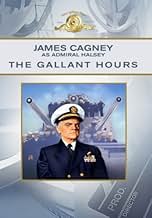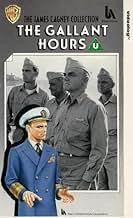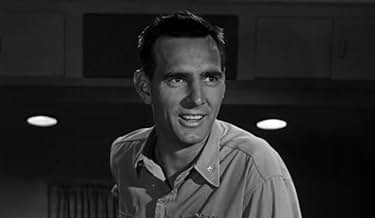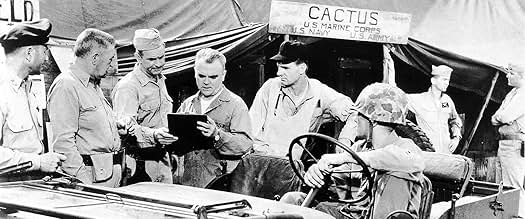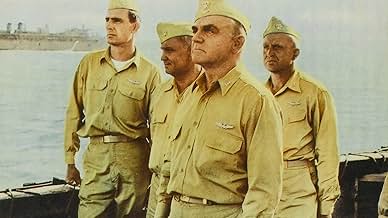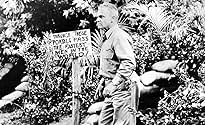CALIFICACIÓN DE IMDb
7.1/10
2.1 k
TU CALIFICACIÓN
El vicealmirante William F. Halsey comanda operaciones navales estadounidenses en el Pacífico Sur durante cinco semanas clave que conducen a la victoria aliada en Guadalcanal.El vicealmirante William F. Halsey comanda operaciones navales estadounidenses en el Pacífico Sur durante cinco semanas clave que conducen a la victoria aliada en Guadalcanal.El vicealmirante William F. Halsey comanda operaciones navales estadounidenses en el Pacífico Sur durante cinco semanas clave que conducen a la victoria aliada en Guadalcanal.
- Dirección
- Guionistas
- Elenco
- Dirección
- Guionistas
- Todo el elenco y el equipo
- Producción, taquilla y más en IMDbPro
Opiniones destacadas
An unexpected *little* film from James Cagney. No snappy dancing, no slapping dames and bartenders around, no grapefruit saying hello to your face, no weird little body dance with the hitching up of pants, hunching the shoulders or snapping of fingers. No strutting or shooting locomotive engineers, no `Made it, Ma! Top of the World!.' Not even a glimpse of the old and much loved Warner Brothers logo for that matter.
In The Gallant Hours, Cagney, normally a smorgasbord of tics, sideways delights, raw energy, menace, and American good-guyism, does the least expected thing: he strips himself of all his familiar trademarks and instead delivers the most restrained, internalized, uncagneylike performance we've ever seen. Too bad it's a one-dimensional misrepresentation of the man he's playing---the crusty, bushy-eyed Fleet Admiral William F. *Bull* Halsey. But more about that in a minute.
Shot in black and white in semi-documentary style, The Gallant Hours is a low-budget, bare-bones, *cameo* production that doesn't attempt either the wide scope or the heroics of such better-known war films as Flying Fortress, Wake Island or Bataan. Instead, the film tightly focuses on the series of crucial, life-and-death decisions made by Admiral Halsey as he directs the desperate struggle in 1942 for possession of Guadalcanal, after it was discovered that the Japanese were building an airfield there from which they could launch attacks on Australia.
Produced and directed by actor and former naval officer Robert Montgomery, the film is a melange of the good, the bad, and the indifferent. The Gallant Hours has its moments, beginning auspiciously with a memorable opening scene of a lone sailor standing high up on a ship's mast, the camera then slowly panning down to reveal the rest of the ship's company massed on deck behind Halsey, who's crisply reading out his retirement orders. This is followed by a touching and well-done scene between him and his filipino valet, the two of them recalling the bloody, extended battle for Guadalcanal, which the film then turns to in extended flashback.
In place of battle action---there is none---the movie pads itself with several lightweight scenes that are either frivolous or yawn-inducing, such as when Halsey's aides, gathered on the beach, are oohing and ahhing over the ageing Admiral's prowess in the water, and, after Halsey has rejoined them, all of them then indulgently observing Dennis Weaver (as Halsey's chief pilot, Lt. Commander Andrew Jefferson 'Andy' Lowe) romping with a group of adoring navy nurses who are all agog over Dennis's tactical maneuvers.
The picture would have benefitted from scrapping fluff like this and sticking to the business of waging war, but no, the scriptwriters instead assume we require *entertainment*---the more mindless the better---in the form of multiple scenes of Dennis Weaver pursuing tail, or---the running gag for the first third of the film---Halsey finding ways of avoiding the innoculation shots that his medical officer wants to give him. Very jolly.
The production as a whole is intensely stylized and displays a palpable mood of mournfulness and regret over the horrific sacrifice of life among the Americans and their allies, who were desperately attempting to roll back the powerful Japanese advance in the South Pacific. This atmosphere is maintained throughout the film by the use of a soaring hymn-like musical score which suggests that the war at sea was virtually a holy war by the Allied Forces to save the world from the rampaging Axis powers.
Montgomery's direction is uneven and occasionally downright lazy, as when he several times settles for using the same boring establishing shot of Halsey's flagship sitting like a stilllife in port. Maybe, just once, he could have tried something else to establish the scene? And the sight of Dennis Weaver---one of my favorite actors---made to endlessly pursue more-than-willing navy nurses for comic relief shortly becomes tedious. Deprived of the opportunity to show battle action, the scriptwriters frequently appear to be vamping, for want of anything better to do.
For anyone who's seen John Ford's magnificent, eligiac 1945 wartime drama, They Were Expendable, in which Montgomery and John Wayne had starred, it will be obvious that the concept for The Gallant Hours was strongly influenced by the earlier film. Given the chance to direct, Montgomery apparently believed that what Ford could do, *he* could do better. But where Ford had sown his film with subtle tones of sadness, defeat, and loss, Montgomery drenches The Gallant Hours with painted-on emotion, conveyed primarily by its endlessly repeated score and a narrator who crisply and regularly informs you about which onscreen marine will be dead or badly injured in battle forty-five minutes later. They Were Expendable, now recognized as one of Ford's finest films, was effective without having to repeatedly cue its audience, while The Gallant Hours finds it necessary to frequently poke us when it's time to feel sad again or to grieve over incidents that are never depicted.
None of the above, however, is as off-kilter as the picture's biggest disappointment---its highly *edited* depiction of Halsey. The scriptwriters did an outrageous disservice to the public memory of Halsey by sanitizing the admiral into a nearly flawless, one-dimensional cardboard cutout---nearly a saint. He wasn't. According to his biographers, *Bull* Halsey was a salty, aggressive, Ulysses S. Grant-type warrior who liked his liquor---at one point he was receiving a monthly ration of seventeen cases of Scotch and six of bourbon, both for himself and for the purposes of entertaining others---and whose hatred of the Japanese was legendary and who exalted in killing them in large numbers, often allowing them to drown in the sea rather than picking them up and taking them prisoner. This was a man who was famous in naval circles for once erecting a large billboard that said, `Kill Japs! Kill Japs! Kill more Japs!' This wasn't a guy who, like his Japanese counterpart, Admiral Yamamoto, spent quality time arranging flowers to look just right for snapping with his Leica. Unsurprisingly, he was capable of exhibiting a ferocious temper if provoked and had other colorful human failings as well. The men who served with and under him loved and respected him in part for his being altogether human, for being one of them.
The Gallant Hours may get away with failing to show battle action, but it rolls over and dies when it fashions an utterly false picture of this great American wartime figure as a benign plaster saint who was followed by heavenly music wherever he went. Halsey's business was killing the enemy, not serving the Host to them during the Eucharist.
As for the film's lead, admittedly it is simply not possible to watch Jimmy Cagney and not enjoy him. The guy doesn't know how *not* to be interesting. But I would much rather have seen him play one of America's greatest naval warriors with all of that individual's various human qualities intact. It would have made for a much more compelling film.
In The Gallant Hours, Cagney, normally a smorgasbord of tics, sideways delights, raw energy, menace, and American good-guyism, does the least expected thing: he strips himself of all his familiar trademarks and instead delivers the most restrained, internalized, uncagneylike performance we've ever seen. Too bad it's a one-dimensional misrepresentation of the man he's playing---the crusty, bushy-eyed Fleet Admiral William F. *Bull* Halsey. But more about that in a minute.
Shot in black and white in semi-documentary style, The Gallant Hours is a low-budget, bare-bones, *cameo* production that doesn't attempt either the wide scope or the heroics of such better-known war films as Flying Fortress, Wake Island or Bataan. Instead, the film tightly focuses on the series of crucial, life-and-death decisions made by Admiral Halsey as he directs the desperate struggle in 1942 for possession of Guadalcanal, after it was discovered that the Japanese were building an airfield there from which they could launch attacks on Australia.
Produced and directed by actor and former naval officer Robert Montgomery, the film is a melange of the good, the bad, and the indifferent. The Gallant Hours has its moments, beginning auspiciously with a memorable opening scene of a lone sailor standing high up on a ship's mast, the camera then slowly panning down to reveal the rest of the ship's company massed on deck behind Halsey, who's crisply reading out his retirement orders. This is followed by a touching and well-done scene between him and his filipino valet, the two of them recalling the bloody, extended battle for Guadalcanal, which the film then turns to in extended flashback.
In place of battle action---there is none---the movie pads itself with several lightweight scenes that are either frivolous or yawn-inducing, such as when Halsey's aides, gathered on the beach, are oohing and ahhing over the ageing Admiral's prowess in the water, and, after Halsey has rejoined them, all of them then indulgently observing Dennis Weaver (as Halsey's chief pilot, Lt. Commander Andrew Jefferson 'Andy' Lowe) romping with a group of adoring navy nurses who are all agog over Dennis's tactical maneuvers.
The picture would have benefitted from scrapping fluff like this and sticking to the business of waging war, but no, the scriptwriters instead assume we require *entertainment*---the more mindless the better---in the form of multiple scenes of Dennis Weaver pursuing tail, or---the running gag for the first third of the film---Halsey finding ways of avoiding the innoculation shots that his medical officer wants to give him. Very jolly.
The production as a whole is intensely stylized and displays a palpable mood of mournfulness and regret over the horrific sacrifice of life among the Americans and their allies, who were desperately attempting to roll back the powerful Japanese advance in the South Pacific. This atmosphere is maintained throughout the film by the use of a soaring hymn-like musical score which suggests that the war at sea was virtually a holy war by the Allied Forces to save the world from the rampaging Axis powers.
Montgomery's direction is uneven and occasionally downright lazy, as when he several times settles for using the same boring establishing shot of Halsey's flagship sitting like a stilllife in port. Maybe, just once, he could have tried something else to establish the scene? And the sight of Dennis Weaver---one of my favorite actors---made to endlessly pursue more-than-willing navy nurses for comic relief shortly becomes tedious. Deprived of the opportunity to show battle action, the scriptwriters frequently appear to be vamping, for want of anything better to do.
For anyone who's seen John Ford's magnificent, eligiac 1945 wartime drama, They Were Expendable, in which Montgomery and John Wayne had starred, it will be obvious that the concept for The Gallant Hours was strongly influenced by the earlier film. Given the chance to direct, Montgomery apparently believed that what Ford could do, *he* could do better. But where Ford had sown his film with subtle tones of sadness, defeat, and loss, Montgomery drenches The Gallant Hours with painted-on emotion, conveyed primarily by its endlessly repeated score and a narrator who crisply and regularly informs you about which onscreen marine will be dead or badly injured in battle forty-five minutes later. They Were Expendable, now recognized as one of Ford's finest films, was effective without having to repeatedly cue its audience, while The Gallant Hours finds it necessary to frequently poke us when it's time to feel sad again or to grieve over incidents that are never depicted.
None of the above, however, is as off-kilter as the picture's biggest disappointment---its highly *edited* depiction of Halsey. The scriptwriters did an outrageous disservice to the public memory of Halsey by sanitizing the admiral into a nearly flawless, one-dimensional cardboard cutout---nearly a saint. He wasn't. According to his biographers, *Bull* Halsey was a salty, aggressive, Ulysses S. Grant-type warrior who liked his liquor---at one point he was receiving a monthly ration of seventeen cases of Scotch and six of bourbon, both for himself and for the purposes of entertaining others---and whose hatred of the Japanese was legendary and who exalted in killing them in large numbers, often allowing them to drown in the sea rather than picking them up and taking them prisoner. This was a man who was famous in naval circles for once erecting a large billboard that said, `Kill Japs! Kill Japs! Kill more Japs!' This wasn't a guy who, like his Japanese counterpart, Admiral Yamamoto, spent quality time arranging flowers to look just right for snapping with his Leica. Unsurprisingly, he was capable of exhibiting a ferocious temper if provoked and had other colorful human failings as well. The men who served with and under him loved and respected him in part for his being altogether human, for being one of them.
The Gallant Hours may get away with failing to show battle action, but it rolls over and dies when it fashions an utterly false picture of this great American wartime figure as a benign plaster saint who was followed by heavenly music wherever he went. Halsey's business was killing the enemy, not serving the Host to them during the Eucharist.
As for the film's lead, admittedly it is simply not possible to watch Jimmy Cagney and not enjoy him. The guy doesn't know how *not* to be interesting. But I would much rather have seen him play one of America's greatest naval warriors with all of that individual's various human qualities intact. It would have made for a much more compelling film.
Robert Montgomery directs this brief, but informative study of Adm. William F. 'Bull' Halsey Jr. in the Pacific during WWII. James Cagney is super as the highly decorated and revered Fleet Commander. Stoic, stern, confident and compassionate...Cagney in one of his best film performances.
Supporting cast is a mix of veteran actors and younger stars: Walter Sande, Les Tremayne, Dennis Weaver, Richard Jaeckel, James Yagi, Robert Burton and Ward Costello.
Supporting cast is a mix of veteran actors and younger stars: Walter Sande, Les Tremayne, Dennis Weaver, Richard Jaeckel, James Yagi, Robert Burton and Ward Costello.
This classic film is about Admiral Halsey's leadership of the US forces in the South Pacific during the early part of World War II. The film is more about leadership than warfare. Combat is not depicted on screen, so this film would not appeal to those who seek lots of action. I strongly recommend the film, especially to history buffs.
When in the days that pass this life that we live,if you happen to come upon this film keep it,view it,and know truly that this is what is meant by the golden age of Hollywood.This is not about the roaring twenties or the 1940s or in fact anything that you can touch.It is a film that involves a time when we in our resolve as a sovereignty were to be attacked by surprise and while unable to provide front line support sufficient to deter such unwarranted aggression we did what we could to figure out how to do what we had as yet been unable to do and that is stop the Japanese.Our military history will recognize that the defense of Guadalcanal will be recognized as a perimeter that was held and cleared at great cost.However,the ability of the Marine Corps to hold were aided by the very gallant efforts of our Navy and so many others that though Guadalcanal was the focus of our efforts,the reader might do well to look up Defense of the South Pacific.This was in fact when we started to take back what was a very high cost to relinquish.Names like battle of savo island,The straights of Iron Bottom Sound,the Solomons,The Tokyo Express,you will learn just how drama can unfold on the silver screen without running up a 300 million dollar tab.This film is about a ordinary man in Admiral William Halsey who at a very critical time in our efforts in the South Pacific took command of our defenses and in a matter of speaking light a fire and proceeded to defend and ultimately defeat the aggression of a dangerous and superior force in the Japanese.This film is not to go past when you come to it.I am personally pleased that where I was a youngster when I first viewed this very fine film, fortunately it has been made available through videotape(VHS)and maybe those that know better would know that these are the films we truly care for.This is in defense of the Gallant Hours, it would do well as a fine package in Digital Versatile Disc.I do not think you can do any better a movie than The Gallant Hours.I can not recommend a picture any more highly than I than this film.A moving tribute to a very ordinary man who said that he would get the credit for the work that was started by others.A worthy movie going experience.It might be well to know that there are subtle ways by which this movie becomes a picture worth saving and it is emphasized in the following words,"I knew a lad who went to sea and left the shore behind him,the lad was me and now I can not find him.Away,away,away he went and left the shore behind him."A do not miss.Sincerely
Arrgghh!! Whether or not this is a good film, I am surprised that most of the reviewers don't mention the god-awful men's chorus that inappropriately drones on and one with even greater solemnity than a Biblical epic!! It's horrible and annoying--and undermines much of the film. Why this was chosen for the soundtrack I have no idea, as it grates on the nerves like no other soundtrack I can recall! Yes, it's that bad and after a while it sounds almost like bees swarming--I kid you not! Aside from the demoniacally-inspired chorus, the next thing you'll probably notice is the unusual style of the film. Instead of a typical bio-pic, this one is told in a semi-documentary style--with very serious narration punctuating various vignettes of a very small portion of Admiral Halsey's life. This small cross-section of his life consists of just five weeks!! So, it's hard to exactly call this a 'bio-pic' as it would seem to imply more than just a tiny portion of the subject's life.
The film is also surprisingly different from what you'd expect because the telling of the story is very straight-forward and without adornment. Simple and direct seem to be the motto for this film...and have a male chorus that sounds worse than cats begin tortured.
If you want a film version of all of Halsey's life or a warts-and-all film, this is not the movie for you. However, it is very competently made and worth seeing...even with the evil chorus from Hell--though I AM deducting two points for this!
The film is also surprisingly different from what you'd expect because the telling of the story is very straight-forward and without adornment. Simple and direct seem to be the motto for this film...and have a male chorus that sounds worse than cats begin tortured.
If you want a film version of all of Halsey's life or a warts-and-all film, this is not the movie for you. However, it is very competently made and worth seeing...even with the evil chorus from Hell--though I AM deducting two points for this!
¿Sabías que…?
- TriviaRear Admirals Scott and Callaghan were both killed in action in the naval battle of Guadalcanal. Admiral Halsey, who received a promotion, asked that his stars be given to the widows of the two men because, he said, their actions earned him that promotion. Halsey could not have known it at the time, but Admiral Scott was killed in a friendly fire incident aboard the USS Atlanta when it was accidentally fired upon by the USS San Francisco.
- ErroresAt the beginning of the move its stated that he retired on 22 November 1945. Halsey actually retired in March 1947.
- Citas
Fleet Admiral William F. 'Bull' Halsey Jr.: There are no great men, only great challenges that ordinary men are forced by circumstances to meet.
- ConexionesFeatured in War Movie Blockbusters (2015)
- Bandas sonorasThe Gallant Hours Theme
Words and Music by Ward Costello
Sung by Roger Wagner Chorale (as The Roger Wagner Chorale)
Selecciones populares
Inicia sesión para calificar y agrega a la lista de videos para obtener recomendaciones personalizadas
- How long is The Gallant Hours?Con tecnología de Alexa
Detalles
- Fecha de lanzamiento
- País de origen
- Idiomas
- También se conoce como
- The Gallant Hours
- Locaciones de filmación
- Marine Corps Base Camp Pendleton, California, Estados Unidos(used for Henderson Field and Gaudacanal)
- Productora
- Ver más créditos de la compañía en IMDbPro
- Tiempo de ejecución1 hora 55 minutos
- Color
- Relación de aspecto
- 1.66 : 1
Contribuir a esta página
Sugiere una edición o agrega el contenido que falta

Principales brechas de datos
What is the Spanish language plot outline for Los tigres del mar (1960)?
Responda


